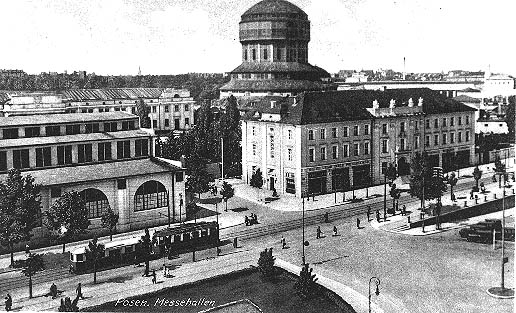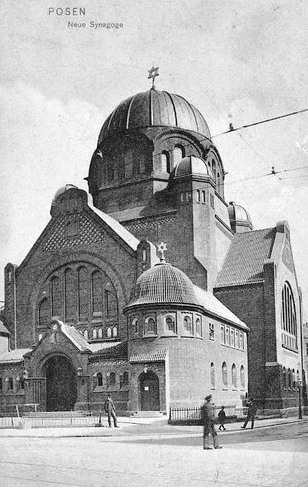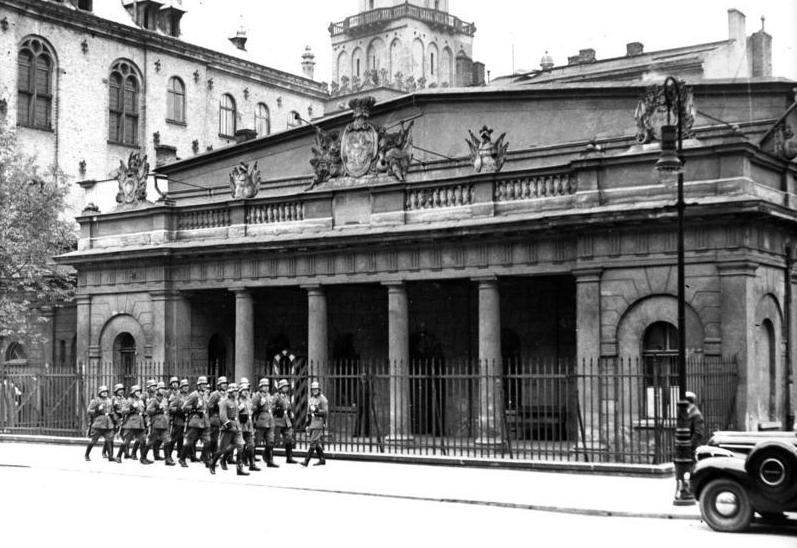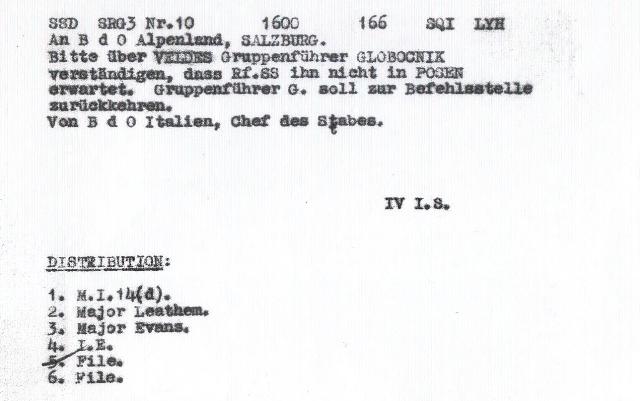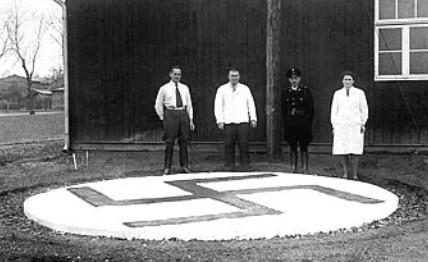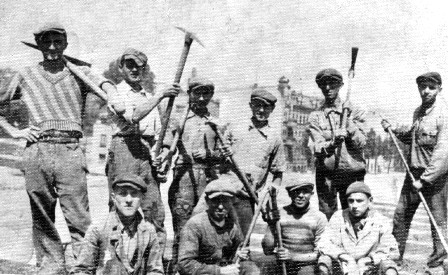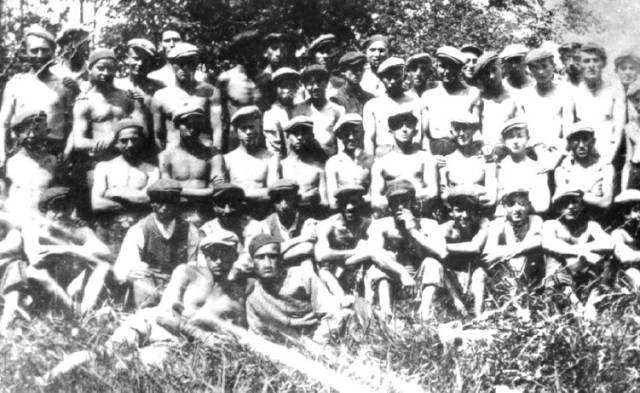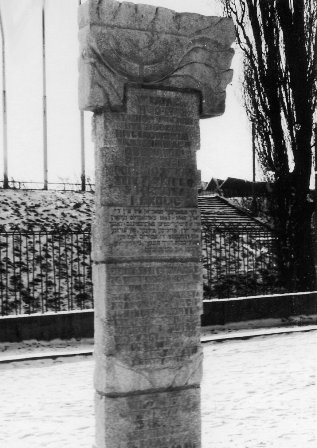Holocaust Education & Archive Research Team |
|
Other Camps
Key Nazi personalities in the Camp System The Labor & Extermination Camps
Auschwitz/Birkenau Jasenovac Klooga Majdanek Plaszow The Labor Camps
Trawniki
Concentration Camps
Transit Camps |
||||
Poznan/Posen and the Camps at Zabikowo
Poznan or Posen as it was known during the occupation is located in Western Poland and during the German occupation between 1939 and 1945, was incorporated into the Reich and became capital of the Wartheland. Jewish refugees may have settled in Poznan after such upheavals as the Rhineland massacres of the First Crusade, the peasant riots of 1248 and the Black Death persecutions of 1348-49.
A Jewish was in existence in the second half of the 14th Century, with Jews engaging in money-lending and money-changing, mostly on a small scale under charters guaranteeing religious freedom and internal autonomy.
In 1399 Jews were murdered and their account books destroyed in one of the recurring anti-Jewish incidents that plagued the community over the centuries. Epidemics and fires also disturbed the community during its early existence.
During the 15th and 16th centuries Jews increasingly migrated to trade and crafts, although there were residence and trade restrictions at this time, by the mid-16th century Jews comprised half the cities population.
There was a general atmosphere of prosperity and the community was one of the most important in Greater Poland, with a much coveted rabbinical seat and a renowned yeshiva. Among the yeshiva heads were R.Shemuel Edels(Maharsha), David ha-Levi(the Taz), author of the well-known Turei Zahav on the Shulhan Arukh, and R. Moshe Lipschitz.
A period of crisis commenced in the mid- 17th century, only 300 of the city’s Jewish families survived the Swedish invasion of 1656 and in the Northern War of the early 18th century the Jews again suffered grievously.
Many Jews left the city during a plague in 1709 and eight years later the Jewish quarter of the city was destroyed by invaders from the so-called Tarnograd Confederation and a year later a great fire destroyed more Jewish homes along with the synagogue.
In 1736 Jews were arrested in a blood libel and held in prison for four years. Throughout the century the process of economic decline continued unabated. With the establishment of Prussian rule in 179, interrupted between 1807-15 when Poznan was included in the Grand Duchy of Warsaw and Jewish rights were suspended, Jews gradually achieved a measure of equality and with increasing education underwent a process of cultural and political Germanisation.
Active among the maskilim was the Hebrew writer and educator David Caro who opened the first modern Jewish school there in 1816. The Jewish population grew to a peak of 7,255 in 1871, but thereafter emigration substantially depleted the community, particularly among the educated class, whilst Jewish tradesmen continued to face strong competition from the city’s Germans and Poles.
In the late 19th century, the community was split in two between the followers of Haskala and religious conservative elements. A Hovevei Zion group was formed in 1895.
The community operated a hospital which was founded in 1887, public health services, an old –peoples home, orphanage and summer camps, most children studied in public schools.. The First World War accelerated the decline in the population as many settled in the interior of Germany, leaving 2,088 Jews in 1921.
Prominent among the Zionist youth movements was Hashomer Hatzair which sent many of its pioneers to Palestine in the 1930’s when the Jews were subjected to violent outbursts of anti-Semitism along with economic boycotts.
The Second World War
The Germans invaded Poland on the 31 August / 1 September 1939 and using blitzkrieg tactics quickly defeated the Polish forces, before the arrival of German troops in early September 1939, many Jews fled Poznan, seeking refuge with relatives in other parts of Poland.
The Germans marched into the city on the 10 September 1939 and five days later they confiscated thousands of books that were held in the Jewish library. They forbade Jewish schools to open on the 16 September and they closed Jewish shops on the 20 September 1939.
The Jewish shops were taken over by the NSV (National Socialist Social Welfare) organisation. On the 20 October 1939 the first Jewish victims Benno Rindfleisch and Julius Tychauer were shot at Fort VII. Several more Jews were shot in the same month, in Poznan and in nearby Buk and Kornik.
A resettlement camp for Poles was opened on Baltycka Street in the central district on the 5 November 1939. A week later SS- Obergruppenfuhrer Wilhem Koppe, the Higher SS and Police Leader Posen – Wartheland, issued instructions for the resettlement of all Jews and 35,000 Poles.
From the 29 November 1939 the Jews of Posen were ordered to wear the Star of David on their chests and a yellow armband on their sleeves. On the 11 December 1939 the Gestapo ordered the Jewish community to organise the assembly of all Posen’s Jews on Baltycka Street at eight o’clock the following morning.
They were placed in a barrack and had their baggage confiscated, the following day approximately 1,500 Jewish people were resettled in the GeneralGouvernement. The majority were deported to Ostrow Lubelski in the Lublin district, whilst others went to the larger cities of Warsaw and Lodz. Those who went to Ostrow Lubelski probably perished at the Belzec and Sobibor death camps.
Seven days after the deportation, the German Trust Office finished the work of confiscating Jewish shops and businesses and on the following morning on the 20 December 1939 Dr Friemart drove to Dziekanka near Gniezno, where he supervised the killing of the Jewish and Polish patients at the mental hospital.
Work began on the conversion of the Stawna Street synagogue into a swimming pool, on the 15 April 1940 the Germans ceremonially removed the last Star of David from the building. The Jewish district had ceased to exist.
It was in Posen, in the town hall, that Heinrich Himmler the Reichsfuhrer-SS made his infamous speech to the higher echelons of the SS on the 4 October 1943, where he talked publically about the extermination of the Jewish race in Europe and the transfer of their property.
One of the higher SS leaders not present was Odilo Globocnik as the intercepted German police decode message revealed.
After the war a Jewish community numbering 200 existed in 1946, but today there are very few Jews left in Poznan.
Labour Camps in Poznan Area
The majority of the Jewish population of Posen and its surrounding areas had been deported by the end of February 1940, but in March 1940 the Reich authorities suspended their deportation plans because of the needs of the German war effort.
The first Jewish labour camp in Posen was set up in the buildings attached to the Municipal Stadium on Dolna Wilda Street. It commenced its operation in the spring of 1941. At any given time, there were about a thousand Jews there. They had been arrested, expelled from their homes, or caught during street round-ups.
They were used as forced labourers in public works, construction, gardening and transport projects throughout the city. Most of them had to sleep outdoors in appalling conditions. There was terror, starvation and disease.
There were over twenty camps in the Posen area, Antoninek, Debiec, Franowo , Golecin, Kobylempole, Krzesiny- Piotrowo, Krzyzowniki, Malta, Smochowice, Strzeszyn and Zabikowo.
After the liquidation of the labour camp on Dolna Wilda Street in early 1943 the prisoners were transferred to the labour camp in Krzesiny- Piotrowo, and at the end of 1943 there were still some four to five thousand Jewish prisoners there.
A forced labour camp for Jews was established at Zabikowo, working on construction of the Reichsautobahn connecting Frankfurt am Oder to Posen and Lodz and eventually Warsaw.
On the 10 December 1940 the first transports of Jewish prisoners were sent to the autobahn construction site, in the beginning there were Jews from the Lodz ghetto, but by mid-1941 Jews from Zdunska Wola, Sieradz, Wielun, Pabiance, Gabin, Gostynin and other ghettos of the Warthegau were sent to the site.
By the end of February 1941, 2,400 people came to the construction site from the Lodz ghetto, it is estimated that at least 10,000 people deported from Warthegau ghettos were sent to the twenty-four work camps established along the autobahn.
The Nazis established two labour camps one at Zabikowo located on the Lubon – Poznan border and the other in Kosciuszki Street, wooden barracks served as accommodation for about 300 prisoners deported from the ghettos of Wielun, Zdunska Wola and Sieradz.
A builder’s yard for the autobahn construction site stored stone, gravel and steel girders was established in Koscielna Street. One of the rooms of a neighbouring parish house also served as an auxiliary warehouse.
The prisoners at the two camps were employed for the construction of a narrow-gauge railway track to Komorniki, designed to aid the construction of the autobahn. The others worked on construction of embankments and excavations of the proposed motorway.
Living conditions created by the German administration in the camp included terror, hunger and exhausting work, flogging, and public executions became the norm in the camp, food was of poor quality, so was the clothing, which contributed to the high death rate in Zabikowo.
The Jewish labour was exploited by German private construction companies, acting as sub-contractors, the work of the prisoners provided huge financial benefits.
By mid-1942 the situation on the Eastern Front changed the German’s priorities, and work on the autobahn was ceased. The camps situated along the autobahn under construction were liquidated one after the other.
The prisoners were sent to other forced labour camps in the region, and thus unable to work were sent to the Chelmno death camp, some were retained in Zabikowo to prepare a camp for political prisoners. The Nazis established a Polizeigefangnis der Sicherheitspolizei und Arbeiserziehungslager (Security Police Prison and Educational Labour Camp) in Zabikowo.
By the spring of 1944 the camp was active in parallel with the camp at Fort VII, for which it was an extension. When Fort Number VII was liquidated in April 1944 the commander Reinhold Hans Walter and the guard force of some 80 – 100 SS members moved to the camp at Zabikowo.
The Security Police camp was established at the area of a former brick-yard, it was surrounded with double row of barbed wire, electrically charged with high voltage and watch towers.
Between the wires some dense wire reels were placed, making escape from the camp very difficult indeed, a high wall separated the camp from the outside.
The camp was divided into women’s and men’s sections and political and criminal prisoners were also separated. The Security Police prison was for temporary incarceration, they were then moved to other camps, waiting for interrogations, sentences and executions.
From Zabikowo 28 transports were sent to Concentration Camps, the first transport was directed to Auschwitz, others went to the camps at Gross Rosen, Mauthausen, Sachsenhausen and Ravensbruck.
The camp was chiefly designed for Polish political prisoners, but it held people from other countries and even deserters from the German Army, a separate group included the so-called “Sunday prisoners” who were sent to Zabikowo on Friday night following some minor infractions and after experiencing the usual torments, they were released on Monday mornings.
Some soldiers of Poznan and Pomerania Divisions of the Polish Home Army and Polish resistance were shot in Zabikowo, the bodies were transported to Posen and burned in the Collegium Anatomicum crematory.
Evacuation of the camp commenced at night on the 20 January 1945, with the men going to Sachsenhausen Concentration Camp near Berlin and the women going to the concentration camp at Ravensbruck. The Nazis then set fire to the camp, and eliminated all traces of prisoners who had been shot, by burning the corpses.
The last murder at the camp was the group of 33 people from the Makow Podhalanski area who were shot by their guards, at the Zabikowo cemetery.
On the 26 January 1945 Russian troops of the 2nd Byelorussian Front entered Zabikowo, the German occupation had ended.
Sources: Ludwigsberg Archive The Yad Vashem Encyclopedia of the Ghettos during the Holocaust The Jews of Poznan by Zbigniew Pakula published by Vallentine Mitchell 2003 Reichsautobahn Lager – Zabikowo Martyr’s Museum The Prison of the Security Police and The Educational Camp in Zabikowo – Zabikowo Martyr’s Museum Holocaust Historical Society Wiener Library Public Records Office – Kew Chris Webb Archive *Thanks to Artur Hojan
Copyright: Chris Webb and Victor Smart H.E.A.R.T 2011
|
